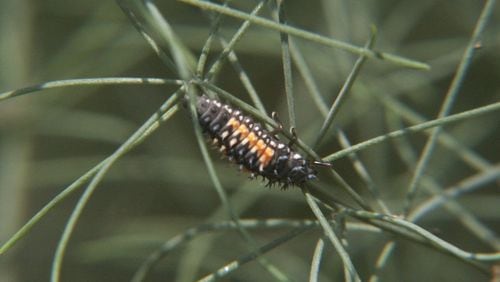Q: My wife wants to control aphids. Are we allowed to import ladybugs from out of state? Roger Mialkowski, Lawrenceville
A: Ladybugs and their larvae are excellent aphid predators. Insects sold at local nurseries have been collected on the West Coast and held in coolers until sold. It’s important to examine a package of purchased ladybugs to be sure they all seem alive. Hold them in a cool spot indoors until you release them at dusk. Lightly mist a plant that has aphids, and scatter the ladybugs at the base of the plant. Next day, some ladybugs will remain, and others will disperse into your neighborhood, looking for more aphid meals. If things go as planned, you’ll see half-inch long, orange and black “alligators” on the plant in a few days. These baby ladybugs are voracious aphid eaters. You can attract a wide variety of other beneficial insects by planting alyssum, dill, bronze fennel, yarrow and carrots in your garden. Allow them all to flower freely, since their nectar is attractive to ladybugs. Another strategy is to wash the aphids off plants with a blast of water, making them prey for ground beetles.
Q: I had some gorgeous Crimson Fire loropetalum shrubs, but they got hit by the freeze. Most of the leaves and flowers turned crispy. Some shrubs rebounded like crazy after about three weeks, but some outer branches are still bare. Sheila Cooper, South Carolina
A: I am learning a lot about how plants respond to freeze damage in my own landscape. In early March, my Japanese snowbell tree was fully leafed out. On March 16 the cold arrived, and all of the leaves froze off. In mid-April there were perhaps three leaves on the bare tree. Now, in late April, it has slowly, but surely, begun uniformly putting out new leaves. I hope the same is true with your loropetalum.
Q: A bulb company sent me a catalog with some good prices on daffodils. What should I do with these bulbs after I receive them in May? Linda Haddix, email
A: Great question. As you know, fall is the best time to plant these spring-flowering beauties. But what to do in spring? My guess is that it would be better to plant them now in a spot that gets a few hours of morning sun and afternoon shade. If the bulbs send up leaves, the foliage will last longer in shade, but the daffodils will naturally go dormant in June. I doubt they will flower, but I could be wrong. They are much more likely to dry out and deteriorate if you keep them out of the ground until the proper planting time in October.
Q: I am wondering how much fertilizer to use on my limelight hydrangeas. Mary Whalen, email
A: Don’t apply much fertilizer to a limelight hydrangea. My preference would be to apply a slow-release organic fertilizer, like Holly-Tone or Milorganite, instead of 10-10-10. The later product will likely cause a growth spurt that will lead to floppy branches in summer.
Q: I understand the best time to fertilize a lawn is when the soil is warmer than 65 degrees. But at what depth? Joe Mascitti, email
A: Measure at the 2-inch depth since that’s where most of the grass roots are growing.
About the Author






